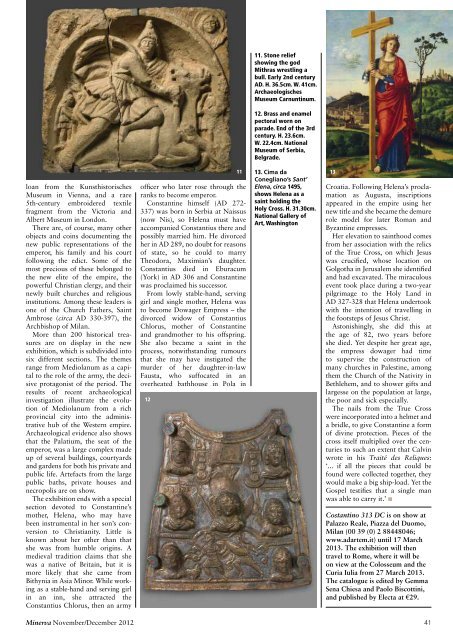Following Odysseus Not the end of the world Amarna city of light ...
Following Odysseus Not the end of the world Amarna city of light ...
Following Odysseus Not the end of the world Amarna city of light ...
- No tags were found...
Create successful ePaper yourself
Turn your PDF publications into a flip-book with our unique Google optimized e-Paper software.
11. Stone reliefshowing <strong>the</strong> godMithras wrestling abull. Early 2nd centuryAD. H. 36.5cm. W. 41cm.ArchaeologischesMuseum Carnuntinum.12. Brass and enamelpectoral worn onparade. End <strong>of</strong> <strong>the</strong> 3rdcentury. H. 23.6cm.W. 22.4cm. NationalMuseum <strong>of</strong> Serbia,Belgrade.loan from <strong>the</strong> KunsthistorischesMuseum in Vienna, and a rare5th-century embroidered textilefragment from <strong>the</strong> Victoria andAlbert Museum in London.There are, <strong>of</strong> course, many o<strong>the</strong>robjects and coins documenting <strong>the</strong>new public representations <strong>of</strong> <strong>the</strong>emperor, his family and his courtfollowing <strong>the</strong> edict. Some <strong>of</strong> <strong>the</strong>most precious <strong>of</strong> <strong>the</strong>se belonged to<strong>the</strong> new elite <strong>of</strong> <strong>the</strong> empire, <strong>the</strong>powerful Christian clergy, and <strong>the</strong>irnewly built churches and religiousinstitutions. Among <strong>the</strong>se leaders isone <strong>of</strong> <strong>the</strong> Church Fa<strong>the</strong>rs, SaintAmbrose (circa AD 330-397), <strong>the</strong>Archbishop <strong>of</strong> Milan.More than 200 historical treasuresare on display in <strong>the</strong> newexhibition, which is subdivided intosix different sections. The <strong>the</strong>mesrange from Mediolanum as a capitalto <strong>the</strong> role <strong>of</strong> <strong>the</strong> army, <strong>the</strong> decisiveprotagonist <strong>of</strong> <strong>the</strong> period. Theresults <strong>of</strong> recent archaeologicalinvestigation illustrate <strong>the</strong> evolution<strong>of</strong> Mediolanum from a richprovincial <strong>city</strong> into <strong>the</strong> administrativehub <strong>of</strong> <strong>the</strong> Western empire.Archaeological evidence also showsthat <strong>the</strong> Palatium, <strong>the</strong> seat <strong>of</strong> <strong>the</strong>emperor, was a large complex madeup <strong>of</strong> several buildings, courtyardsand gardens for both his private andpublic life. Artefacts from <strong>the</strong> largepublic baths, private houses andnecropolis are on show.The exhibition <strong>end</strong>s with a specialsection devoted to Constantine’smo<strong>the</strong>r, Helena, who may havebeen instrumental in her son’s conversionto Christianity. Little isknown about her o<strong>the</strong>r than thatshe was from humble origins. Amedieval tradition claims that shewas a native <strong>of</strong> Britain, but it ismore likely that she came fromBithynia in Asia Minor. While workingas a stable-hand and serving girlin an inn, she attracted <strong>the</strong>Constantius Chlorus, <strong>the</strong>n an army<strong>of</strong>ficer who later rose through <strong>the</strong>ranks to become emperor.Constantine himself (AD 272-337) was born in Serbia at Naissus(now Nis), so Helena must haveaccompanied Constantius <strong>the</strong>re andpossibly married him. He divorcedher in AD 289, no doubt for reasons<strong>of</strong> state, so he could to marryTheodora, Maximian’s daughter.Constantius died in Eburacum(York) in AD 306 and Constantinewas proclaimed his successor.From lowly stable-hand, servinggirl and single mo<strong>the</strong>r, Helena wasto become Dowager Empress – <strong>the</strong>divorced widow <strong>of</strong> ConstantiusChlorus, mo<strong>the</strong>r <strong>of</strong> Constantineand grandmo<strong>the</strong>r to his <strong>of</strong>fspring.She also became a saint in <strong>the</strong>process, notwithstanding rumoursthat she may have instigated <strong>the</strong>murder <strong>of</strong> her daughter-in-lawFausta, who suffocated in anoverheated bathhouse in Pola in121113. Cima daConegliano’s Sant’Elena, circa 1495,shows Helena as asaint holding <strong>the</strong>Holy Cross. H. 31.30cm.National Gallery <strong>of</strong>Art, Washington13Croatia. <strong>Following</strong> Helena’s proclamationas Augusta, inscriptionsappeared in <strong>the</strong> empire using hernew title and she became <strong>the</strong> demurerole model for later Roman andByzantine empresses.Her elevation to sainthood comesfrom her association with <strong>the</strong> relics<strong>of</strong> <strong>the</strong> True Cross, on which Jesuswas crucified, whose location onGolgotha in Jerusalem she identifiedand had excavated. The miraculousevent took place during a two-yearpilgrimage to <strong>the</strong> Holy Land inAD 327-328 that Helena undertookwith <strong>the</strong> intention <strong>of</strong> travelling in<strong>the</strong> footsteps <strong>of</strong> Jesus Christ.Astonishingly, she did this at<strong>the</strong> age <strong>of</strong> 82, two years beforeshe died. Yet despite her great age,<strong>the</strong> empress dowager had timeto supervise <strong>the</strong> construction <strong>of</strong>many churches in Palestine, among<strong>the</strong>m <strong>the</strong> Church <strong>of</strong> <strong>the</strong> Nativity inBethlehem, and to shower gifts andlargesse on <strong>the</strong> population at large,<strong>the</strong> poor and sick especially.The nails from <strong>the</strong> True Crosswere incorporated into a helmet anda bridle, to give Constantine a form<strong>of</strong> divine protection. Pieces <strong>of</strong> <strong>the</strong>cross itself multiplied over <strong>the</strong> centuriesto such an extent that Calvinwrote in his Traité des Reliques:‘... if all <strong>the</strong> pieces that could befound were collected toge<strong>the</strong>r, <strong>the</strong>ywould make a big ship-load. Yet <strong>the</strong>Gospel testifies that a single manwas able to carry it.’ nCostantino 313 DC is on show atPalazzo Reale, Piazza del Duomo,Milan (00 39 (0) 2 88448046;www.adartem.it) until 17 March2013. The exhibition will <strong>the</strong>ntravel to Rome, where it will beon view at <strong>the</strong> Colosseum and <strong>the</strong>Curia Iulia from 27 March 2013.The catalogue is edited by GemmaSena Chiesa and Paolo Biscottini,and published by Electa at €29.Minerva November/December 201241
















